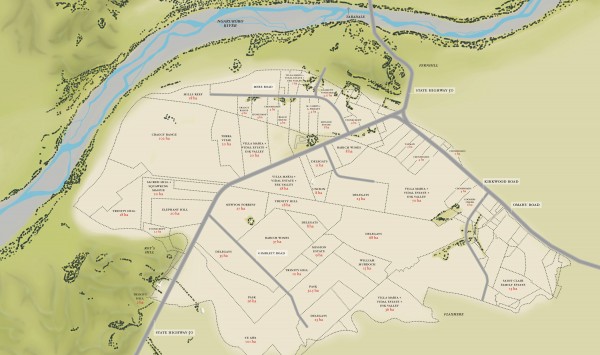January 01, 2018
Gimblett Gravels proves “the poorer the soil, the better the grapes”
One of the joys of representing artisanal New Zealand wines is our ability to share wines and stories from some of the lesser known heroes of Kiwi wines. This week, the NZ Wine Navigator team had the opportunity to highlight our award-winning wines from the Gimblett Gravels Wine Growing District to a select group of sommeliers, wine buyers, and wine media. The Michelin-starred Musket Room in New York City provided the backdrop to this special evening, with wines from Gimblett Gravels blowing away even the most jaded palates.
What makes Gimblett Gravels wine worth exploring?
The Gimblett Gravels Wine Growing District is the only viticultural area in New Zealand that is defined by its soil type rather than a political or geographic boundary, conforming to practices more common to French appellations than New World wine regions. But the “gravels” of Gimblett Gravels tells a story that is uniquely Kiwi.
You see, New Zealand farmers raise a lot of sheep. The Gimblett Gravels were originally the river bed of the Ngaruroro River, but a major flood in 1867 changed its course and exposed dense, stratified gravel soil. To sheep farmers, the land was useless. The soil couldn’t sustain a flock! Instead of supporting the standard 3 sheep (plus lambs) per acre, Gimblett Gravels soil could only support ONE sheep! This was a nightmare for the region. Unable to raise their favorite animal on the Gravels, the city experimented with alternatives, including a drag strip, cold storage, and a firing range.
And yet, the most boring thing happening in the Gravels brought the most drama.
The drama began when the area was put forward as viticultural land by the pioneering Gimblett Gravels winemakers. This was vigorously opposed by a local cement company who were using the gravel at their cement works. The company wanted to mine the gravel on 150 hectares of the land. A legal battle ensued over the next decade leaving the future of the Gravels in doubt. Thankfully, and with incredibly rare civic foresight, the winemakers won and in the 1990’s plantings started in earnest.
As implied in the name, the Gimblett Gravels terroir is primarily stones and stones don’t provide much nutrition for the vines. What they do really well is allow water to drain away, forcing the vines struggle. They also absorb and radiate heat, helping grapes to ripen. As a result, the Gimblett Gravels Wine Growing District is consistently 2-3 degrees warmer than the rest of Hawkes Bay, and underground temperatures can be up to 5 degrees. This warmth allows the vines to continue the ripening process rather than shutting down overnight. Grape vines are incredibly durable, needing far less than most plants to thrive. If the soil is too rich, the vine concentrates on growth rather than grapes. Poor soils cause the vine to concentrate energy on grape production.
In the early days, Gimblett Gravel winemakers started out with white varieties like Muller-Thurgau and Chenin Blanc. But the higher temperatures in the region led to experimental plantings of reds, including New Zealand’s first Syrah. The results were extraordinary. The white vines were yanked out, and the reds took off. The Gimblett Gravels Winegrowing District is now 90% red, planted in varieties similar to those of Bordeaux’s Right Bank: 35% Merlot, 15% Cabernet Sauvignon, 7% Malbec and 4% Cabernet Franc. Their Syrah has performed so well that it now comprises 20% of the Gimblett Gravels plantings and is one of New Zealand’s showcase wines.
"The delight of working with grapes grown in the Gimblett Gravels Wine Growing District, is they make wines that are so expressive with personality and individuality. They have the character of the grape variety with the sense of place woven through the wine. The fragrance, the spice, the restraint inherent in their structural tannins, give the wines distinction.
The vineyard soils within the Gimblett Gravels Wine Growing District vary depending on the gravel to silt mix and each vineyard has its own micro climate dictated by its position relative to Roys Hill, Gimblett Road and Highway 50. The wines can show these variations. They allow the winemaker to create site reflective, transparent wines, of individuality and passion."
Jenny Dobson, Winemaker, Squawking Magpie
The “gravels” tie the region to some of the world’s most famous vineyards. Like the round Galets of Chateauneuf du Pape and the fractured Llicorella of Priorat, the stones are hallmarks of their regions. You’ll see constant references to Bordeaux when discussing the Gravels, with good reason. Hawkes Bay, and specifically the Gimblett Gravels, is the epicentre of Bordeaux-blend production in New Zealand. At a blind tasting in France in 2009, six bottles of Gravels wines and six bottles of Bordeaux were tasted and ranked by wine professionals. Places 1-3 went to Lafite-Rothschild, Mouton-Rothschild and Chateau Angelus respectively, but the shocker was when an £18 New Zealand wine came in at number 4! And then another at number 6! Two out of the top 6 wines were Gimblett Gravels and sold for a fraction of the price of the biggest named wines in the world!

Photos credit: Gimblett Gravels Wine Growing District
Related
Welcome to New Zealand Wine Navigator
By clicking enter, I certify that I am over the legal age for alcohol consumption in my location.
Please note: Ground shipping is included on orders of $200 or more.